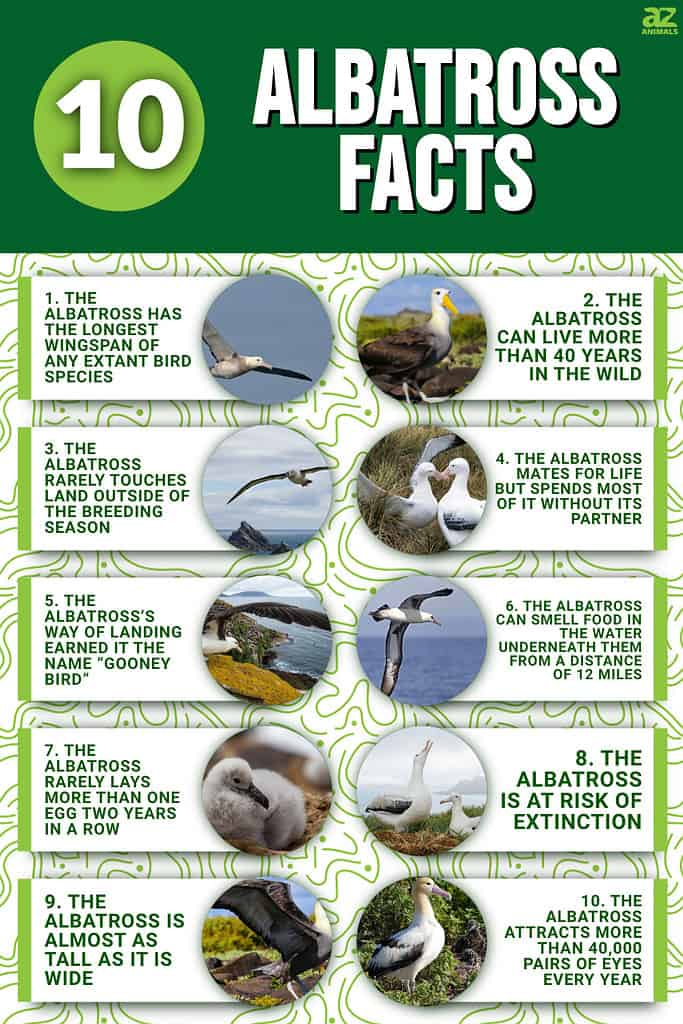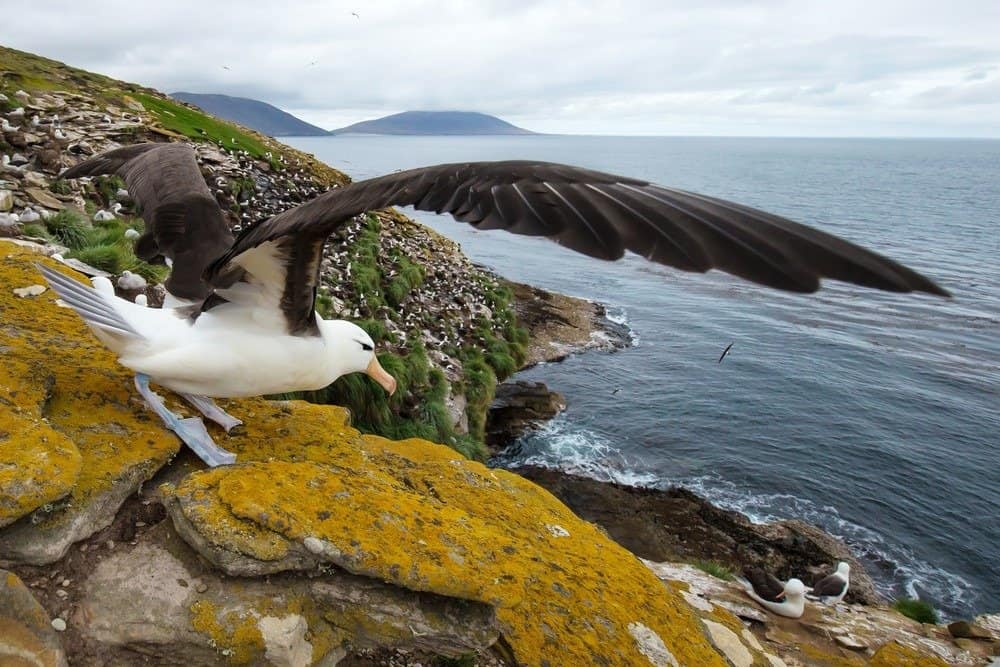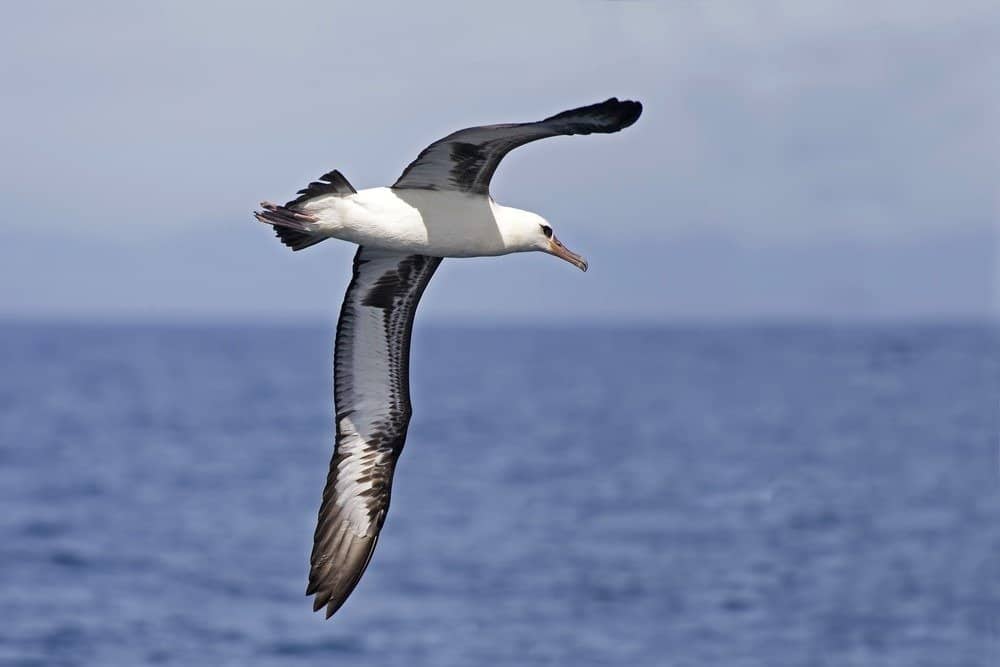The albatross is a large seabird and part of the Diomedeidae biological family. The bird is commonly found in the North Pacific and the Southern Ocean and can’t be seen in the North Atlantic. It is one of the world’s largest flying birds.

Great albatrosses, a species of the Diomedea genus, have the longest wingspan among extant birds-they can reach up to 12 feet (3.7 meters).
These incredible birds are known for their efficiency while flying and the fact that they mate for life. During each breeding season, the female albatross lays only one egg. This is one of the main reasons why 21 of the 22 species of albatross are either critically endangered, near threatened, endangered, or vulnerable.
If you’ve caught a glimpse of a large bird in the ocean sky, it might be an albatross – not a plane or Superman. Here are 10 incredible facts about this amazing species of bird!
1. The albatross has the longest wingspan of any extant bird species

The wingspan of an albatross can reach up to 12 feet.
©Agami Photo Agency/Shutterstock.com
The wingspan of an albatross, specifically the wandering albatross, can reach up to 12 feet (3.7 meters), as mentioned. This characteristic helps them greatly during flight. The second-largest wingspan is attributed to the southern royal albatross, with a wingspan of up to 11 feet (3.3 meters).
Wandering albatrosses can soar up to 500 miles (approximately 800km) in a single day. They can also maintain speeds of around 80 miles per hour (130 kph) for up to eight hours without flapping their wings once. The winds in their flying areas play a role in their flight strategy.
2. The albatross can live more than 40 years in the wild

The albatross can live up to 40 years–one of the longest life expectancies in the animal kingdom.
©Don Mammoser/Shutterstock.com
In 1956, a Laysan albatross named Wisdom was branded by a team of researchers. Roughly 62 years later, a team of biologists found Wisdom in a national wildlife refuge – Hawaii’s Midway Atoll. To showcase the albatrosses’ great life expectancy, Wisdom was just tending to a newly hatched egg when she was rediscovered.
The albatross is a bird with one of the longest life expectancies in the animal kingdom – both among birds and wild animals.
3. The albatross rarely touches land outside of the breeding season

Albatrosses spend most of their lives in the air, and some are even thought to sleep while soaring.
©MZPHOTO.CZ/Shutterstock.com
As soon as albatrosses are prepared for flight, they usually spend at least one year at sea without touching land masses. Most of the time at sea is spent flying, and it is said that albatrosses might even sleep while flying. This fact cannot be currently confirmed. However, the frigatebird—a close relative of the albatross—is known to sleep during flight.
It is said that the albatross can spend years and years at sea without setting foot on land. They only lower their altitude when feeding and land completely during the breeding season.
4. The albatross mates for life but spends most of it without its partner

After hatching, male and female albatrosses fly out of their nests to forage for food.
©iStock.com/slowmotiongli
Albatrosses are known for their ritualized dances that form bonds with female albatrosses. The bond lasts for a lifetime, as albatrosses are monogamous. They spend little time with their partner, however.
A breeding season can last more than a year. During this time, the pair meet at the breeding grounds regularly and briefly until one egg is laid. They take turns incubating it and gathering food. After hatching, male and female albatrosses fly out of their nests to forage for food. One hundred sixty-five days after hatching, the albatross chick fledges (is ready for flight). This is when the pair separates—the reunion will occur during the next breeding season.
5. The albatross’s way of landing earned it the name “gooney bird”

While the albatross may seem graceful in the air, this bird makes a clumsy, comical landing that has inspired animators.
©Giedriius/Shutterstock.com
We’ve all seen albatrosses, especially in movies and TV shows, but we’ve also seen them in animation. The latter has a knack for exaggerating traits of both humans and animals, making this the perfect scenario where you can see what the gooney bird refers to.
When landing, the albatross tumbles forward comically. It is an awkward way to land, especially for a bird that’s so efficient during flight. Since awkward is another word for goony – there you have it!
6. The albatross can smell food in the water underneath them from a distance of 12 miles

A study in 2008 revealed that albatrosses track food via an upwind, zigzag flight.
©Harold Stiver/Shutterstock.com
Smell is a trait most birds, especially seabirds, rely on when searching for food. Given that most of what they eat is fish or smells like fish, it’s clear why smell is of the essence. However, imagine for a second how difficult it is to follow the scent of food in the open ocean—and of underwater food!
The albatross doesn’t experience any difficulty in doing so. A 2008 study equipped 19 birds of the wandering albatross species with GPS sensors. According to the sensors, the albatrosses tracked their food via an upwind, zigzag flight. Scientists believe this is the best method for tracking unusual odors or smells. Albatrosses were often seen using this strategy when they were as far as 12 miles (19 km) away from the food they tracked.
7. The albatross rarely lays more than one egg two years in a row

Female albatrosses lay a single egg during the breeding season.
©Johnny Giese/Shutterstock.com
Female albatrosses lay a single egg during the breeding season. This process is rarely repeated in the following year, as the bird usually skips a year between breeding seasons. One of the reasons behind this might be that a breeding season can last more than one year.
During this time, as mentioned, each partner takes turns incubating the egg – each parent spending up to 40 days with the egg.
8. The albatross is at risk of extinction

©MZPHOTO.CZ/Shutterstock.com
The IUCN recognizes 22 species of albatross. Out of these, 21 are more or less at risk of extinction – 15 species are at immediate risk, 8 species are (critically) endangered, 6 species are near threatened, and another 6 are listed as vulnerable. The main reason for their rapid extinction is the harvesting of their feathers.
Most albatrosses die at sea due to the increased prevalence of fishing nets and lines. Some die as chicks or eggs, mainly due to introduced species of predators, such as feral cats and rats. Plastic in the ocean is also a significant threat, as chicks are occasionally accidentally fed plastic.
9. The albatross is almost as tall as it is wide

The body of an albatross is directly proportional to the span of its wings.
©Don Mammoser/Shutterstock.com
Naturally, the body of an albatross is directly proportional to the span of its wings. As such, you can expect to see quite a large bird if you come across the 12 feet (3.7 meters) wingspan albatross.
The smallest species are around 3 feet (92 centimeters) in height. The large albatross species are known to grow more than 4 feet (122 centimeters) tall. In terms of weight, a decently sized albatross can weigh up to 17 pounds (7.7 kg) and a large one up to 22 pounds (9.9 kg).
10. The albatross attracts more than 40,000 pairs of eyes every year

The majestic albatross is a favorite among birdwatchers worldwide.
©Jlfutari at English Wikipedia, CC BY-SA 3.0, via Wikimedia Commons – License
Bird watching has become a sort of a popular sport, if we may call it that, with millions of enthusiasts all around the world. It is probably one of the most popular pastimes for visitors on a nature escape. The albatross enjoys most of these visitors.
The northern royal albatrosses form multiple colonies in New Zealand, making the country a popular attraction among bird watchers. According to statistics, 40,000 people come to watch the albatross colonies here.
The photo featured at the top of this post is © Vladimir Strnad/Shutterstock.com
Thank you for reading! Have some feedback for us? Contact the AZ Animals editorial team.






